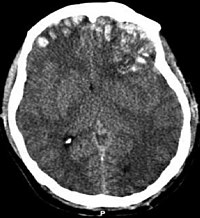
Supporting families through paediatric brain tumour: Unmet needs and suggestions for change.
Sign Up to like & getrecommendations! Published in 2023 at "Psycho-oncology"
DOI: 10.1002/pon.6136
Abstract: OBJECTIVE From diagnosis and beyond, a paediatric brain tumour and its treatment impact the child and their family in a myriad of ways. While it is considered best practice to offer ongoing psychosocial support for… read more here.
Keywords: family; brain; brain tumour; paediatric brain ... See more keywords

[P169] Can lead shielding during paediatric brain radiotherapy reduce the risk of secondary cancer?
Sign Up to like & getrecommendations! Published in 2018 at "Physica Medica"
DOI: 10.1016/j.ejmp.2018.06.469
Abstract: Purpose Radiotherapy of paediatric patients comes at the expense of increased secondary cancer risk. This study examines whether the use of a 1 mm lead shielding during volumetric-modulated arc therapy (VMAT) for paediatric brain cancer can… read more here.
Keywords: risk; radiotherapy; lead shielding; cancer ... See more keywords

Cancer: Epilepsy caused by BRAF-mutated paediatric brain tumours gets a REST
Sign Up to like & getrecommendations! Published in 2018 at "Nature Reviews Drug Discovery"
DOI: 10.1038/nrd.2018.185
Abstract: epileptic seizures that are resistant to therapies. A new article in Nature Medicine shows that BRAF-V600E — an oncogenic mutation that is often found in melanomas — is also found in about half of epilepsyassociated… read more here.
Keywords: epilepsy; braf v600e; brain tumours; braf ... See more keywords

Epigenetic mechanisms in paediatric brain tumours: regulators lose control.
Sign Up to like & getrecommendations! Published in 2022 at "Biochemical Society transactions"
DOI: 10.1042/bst20201227
Abstract: Epigenetic mechanisms are essential to regulate gene expression during normal development. However, they are often disrupted in pathological conditions including tumours, where they contribute to their formation and maintenance through altered gene expression. In recent… read more here.
Keywords: mechanisms paediatric; paediatric brain; brain tumours; tumours regulators ... See more keywords

Paediatric brain abscesses: a single centre experience
Sign Up to like & getrecommendations! Published in 2019 at "British Journal of Neurosurgery"
DOI: 10.1080/02688697.2019.1587381
Abstract: Abstract Introduction: Brain parenchymal abscesses are relatively infrequent but potentially serious infections in the paediatric population. Surgical intervention in addition to a prolonged administration of antibiotics is generally appropriate management. This study presents our centre’s… read more here.
Keywords: surgical intervention; single centre; brain; paediatric brain ... See more keywords

THER-03. IN VITRO EVALUATION OF THE EFFECT OF CANNABIDIOL ON PAEDIATRIC BRAIN TUMOUR CELL LINES USING A PULSED TREATMENT REGIME
Sign Up to like & getrecommendations! Published in 2020 at "Neuro-Oncology"
DOI: 10.1093/neuonc/noaa222.853
Abstract: Abstract Paediatric brain tumours are the second most common cancer after haematological malignancies. Intermittent dosing regimens are typical for chemotherapy drugs in order to avoid excessive damage to organs and avoid the onset of late… read more here.
Keywords: tumour cell; cell; cell lines; brain tumour ... See more keywords

O19 Development of a paediatric brain PBPK model in children with and without meningitis
Sign Up to like & getrecommendations! Published in 2019 at "Archives of Disease in Childhood"
DOI: 10.1136/archdischild-2019-esdppp.19
Abstract: Background Several paediatric physiologically-based pharmacokinetic (PBPK) models have been developed that incorporate developmental changes affecting plasma drug concentrations. Disposition into cerebrospinal fluid (CSF) is also age-related and influenced by physiological factors, including CSF production rate,… read more here.
Keywords: meningitis; paediatric brain; model; pbpk model ... See more keywords

Fitness, body composition and vascular health in adolescent and young adult survivors of paediatric brain cancer and cranial radiotherapy
Sign Up to like & getrecommendations! Published in 2017 at "International Journal of Adolescent Medicine and Health"
DOI: 10.1515/ijamh-2017-0082
Abstract: Abstract Background Survivors of paediatric brain cancer and/or cranial radiotherapy (CRT) are at an increased risk of developing serious comorbidities. Established risk factors for chronic disease include central obesity, endothelial abnormalities and diminished fitness. Objectives… read more here.
Keywords: brain cancer; body composition; survivors paediatric; paediatric brain ... See more keywords

Advances in CAR T cell immunotherapy for paediatric brain tumours
Sign Up to like & getrecommendations! Published in 2022 at "Frontiers in Oncology"
DOI: 10.3389/fonc.2022.873722
Abstract: Brain tumours are the most common solid tumour in children and the leading cause of cancer related death in children. Current treatments include surgery, chemotherapy and radiotherapy. The need for aggressive treatment means many survivors… read more here.
Keywords: car cell; brain tumours; brain; paediatric brain ... See more keywords

Zebrafish Models of Paediatric Brain Tumours
Sign Up to like & getrecommendations! Published in 2022 at "International Journal of Molecular Sciences"
DOI: 10.3390/ijms23179920
Abstract: Paediatric brain cancer is the second most common childhood cancer and is the leading cause of cancer-related deaths in children. Despite significant advancements in the treatment modalities and improvements in the 5-year survival rate, it… read more here.
Keywords: models paediatric; brain; paediatric brain; brain tumours ... See more keywords